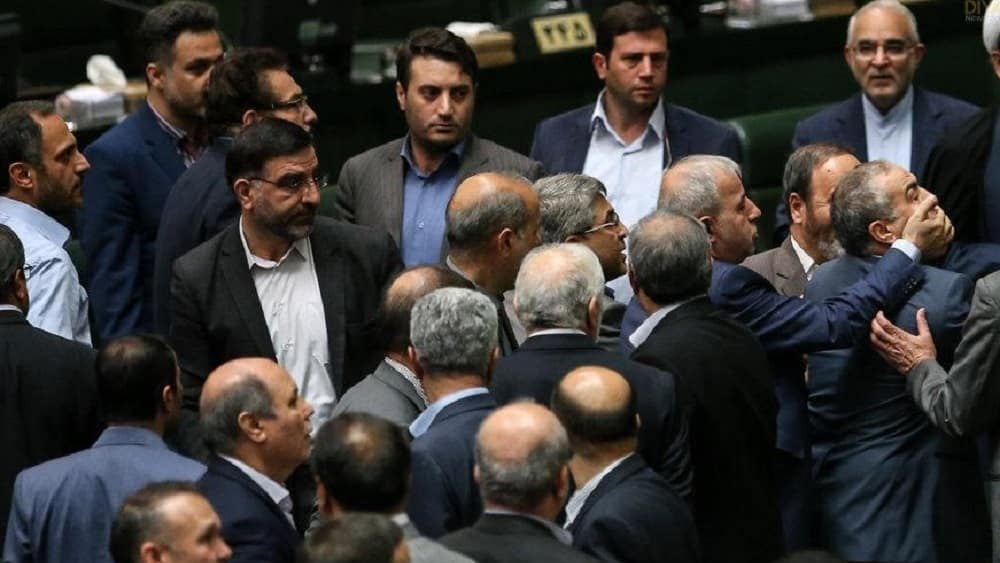Facebook
Twitter
LinkedIn
Pinterest
Reddit
Email
Print
 File photo: Fighting in Iran’s regime Parliament
File photo: Fighting in Iran’s regime Parliament
Three-minute read
In the wake of the recent “12-day war,” the Iranian regime is broadcasting a message of strength, but a torrent of revelations from its own officials paints a starkly different picture: one of a state in a terminal tailspin. The conflict, far from being a victory, has acted as a catalyst, exposing catastrophic intelligence failures, igniting a paranoid purge of the “enemy within,” and accelerating a full-blown political and economic crisis that threatens the very foundation of the clerical dictatorship.
A Military Debacle of Betrayal and Incompetence
The conflict exposed stunning vulnerabilities within the regime’s security and intelligence apparatus. According to regime insider Fayyaz Zahed, speaking on July 14, the precision of enemy strikes points directly to high-level infiltration. Recounting an attack on a high-level meeting, he noted, “Nine gentlemen came to the Joint Staff, one was late. They waited for the tenth person to arrive and then struck the place.” He added, “One must find the person who knew which building to direct General Kazemi to.”
This points to a system compromised from within. Zahed also revealed a damning timeline: “Mr. Jebelli [head of state broadcasting] says that at 1:30 AM, General [Hossein] Salami called him and said, ‘We are going to be attacked tonight.’” Despite this advance warning, key IRGC commanders were still targeted and killed. Former Communications Minister Mohammad Javad Azari Jahromi confirmed that a senior commander’s location was compromised, blaming the regime’s own digital infrastructure. He noted that the state’s mandatory linking of bank accounts to mobile phone numbers creates a treasure trove of data for any adversary, stating, “A single access to a mobile operator’s database clarifies a lot of information for the enemy.”
Fierce Infighting in #Iran’s Clerical Regime Over Hijab Law and Political Power Struggleshttps://t.co/16WRvW0UFn
— NCRI-FAC (@iran_policy) March 14, 2025
Paranoia, Purges, and the “Enemy Within”
The military humiliation has ignited a witch-hunt within the ruling elite. On July 14, Judiciary Chief Gholam-Hossein Mohseni-Ejei warned of “satanic forces” and “murjifun” (spreaders of discord) working to “create false dual-polarization and schisms.” His paranoia was echoed by the Friday prayer leader in Karaj, Mohammad-Mehdi Hosseini Hamedani, who declared on July 11 that the enemy’s new tactic is to “recruit soldiers from within the front of the ‘self’” to spread defeatist news and undermine the system.
This rhetoric of internal enemies coincides with the suspicious death of Ali Taeb, announced on July 12. Taeb was the former representative of the Supreme Leader in the Sarallah Base—the IRGC unit responsible for violently suppressing dissent in Tehran—and the brother of the infamous former IRGC intelligence chief, Hossein Taeb. Regime media conspicuously refused to provide a cause of death, fueling speculation that his demise is part of an internal purge as factions settle scores in the aftermath of the security breakdown. Meanwhile, the head of the Martyrs Foundation, Saeed Ohadi, admitted on July 14 that even now, “a number of people are still missing in Evin Prison” following recent events.
Internal Strife and Conflicting Signals Paralyze #Tehran’s Nuclear Policyhttps://t.co/K2GbNTCacU
— NCRI-FAC (@iran_policy) May 19, 2025
Political System Under Siege
While the regime’s core turns on itself, challenges to its legitimacy are mounting. Former Prime Minister Mir-Hossein Mousavi issued a statement calling for a “constituent assembly to change the system,” a direct challenge to the Supreme Leader’s absolute authority. The regime’s reaction was one of pure panic. Kayhan, Khamenei’s mouthpiece, ran a headline on July 13 asking, “Is this a statement or a dictate from Israel and America?!” It accused Mousavi of reviving the enemy’s “unfulfilled goal” from the 12-day war. IRGC-affiliated media outlets similarly condemned the statement as an attempt to “deepen social and political divisions at a sensitive juncture.”
Underpinning this political unraveling is a state of near-total economic collapse. On July 15, a member of the regime’s parliament, Meysam Zohourian, confirmed that the government has approved the printing of 200,000 and 500,000 Toman banknotes. This is a desperate measure to paper over systemic bankruptcy that will inevitably fuel hyperinflation and further crush the Iranian people. In the same breath, the official admitted that the regime has still not “fully discovered the reason” for the recent crisis that struck major state-owned institutions Bank Sepah and Bank Pasargad, revealing a leadership that is not only broke but also clueless.
The events following the “12-day war” are not isolated incidents but symptoms of a terminal disease. A compromised military, a paranoid leadership consumed by internal purges, a crumbling economy, and growing challenges to the regime’s legitimacy all signal a clerical dictatorship losing its grip.
The regime’s propaganda—claiming the war sparked an “around the flag” effect—is melting under the harsh sunlight of post-war reality. The truth of the war’s aftermath has pierced the illusion, revealing a fractured system haunted by fear, not fueled by unity.